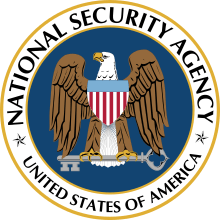Joseph Wenger
Joseph Numa Wenger (June 7, 1901 – September 2, 1970) was a Rear-Admiral of the United States Navy who served as the first Deputy Director of the Armed Forces Security Agency (AFSA), and later as the first Vice Director of the National Security Agency, from December 1952 to November 1953, after the separate divisions of the AFSA merged into the NSA. Wenger was one of the leaders responsible for the development of the NSA.[1] He was a native of Patterson, Louisiana.[2]
Joseph N. Wenger | |
|---|---|
 | |
| 1st Deputy Director of the AFSA, USN | |
| In office November 1950 – April 1951 | |
| Preceded by | position created |
| Succeeded by | Travis Hetherington |
| 1st Vice Director of the NSA | |
| In office December 1952 – November 1953 | |
| Preceded by | Travis Hetherington |
| Succeeded by | John Ackerman |
| Personal details | |
| Born | Joseph Numa Wenger June 7, 1901 Patterson, Louisiana, U.S. |
| Died | September 2, 1970 (aged 69) Washington, D.C., U.S. |
| Resting place | Arlington National Cemetery |
| Military service | |
| Allegiance | USA |
| Branch/service | |
| Rank | Rear-Admiral |
Work
Wenger was "one of the architects of centralized cryptology."[3] In February 1942 Navy power struggles led to the ousting of Laurance Safford from OP-20-G; with two new sections to be headed by Wenger (Communications: Decryption and Translation) and John R. Redman (Communications: Combat Intelligence). Safford was removed from current intelligence to a support and research role.[4] Safford was sidelined for the remainder of the war, as ultimately was Joseph Rochefort.
Wenger was integral in starting the AFSA (Armed Forces Security Agency), the predecessor to the NSA. During World War II he suggested that the Navy spend $2 million "to build 360 of its own four wheel bombes" to break the effective British monopoly on the Bombe.[5] He died in 1970.[6]
See also
References
- "Rear Admiral Joseph N. Wenger, USN (1901–1970) 2005 Inductee". National Security Agency. January 15, 2009. Retrieved January 21, 2009.
- "Cryptologic Almanac 50th Anniversary Series" (PDF). Archived from the original (PDF) on October 28, 2011. Retrieved March 8, 2012.
- Hatch, David A.; Robert Louis Benson. "The Korean War: The SIGINT Background Search What's new?". United States National Security Agency. Retrieved December 21, 2008.
- Layton, Edwin (1985). And I was there: Pearl Harbour and Midway – Breaking the Secrets. New York: William Morrow. pp. 367, 368. ISBN 0-688-04883-8.
-
- Budiansky, Stephen (2000). Battle of Wits. New York: The Free Press.
External links
| Preceded by position created |
Deputy Director of the Armed Forces Security Agency, USN 1950–1951 |
Succeeded by Travis Hetherington |
| Preceded by Travis Hetherington |
Vice Director of the National Security Agency 1952–1953 |
Succeeded by John Ackerman |
